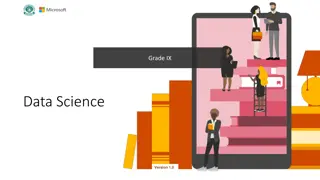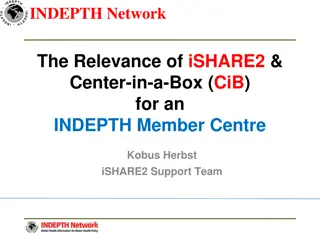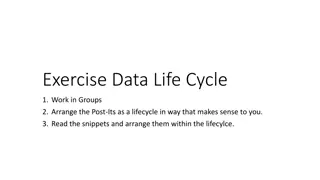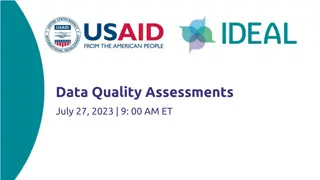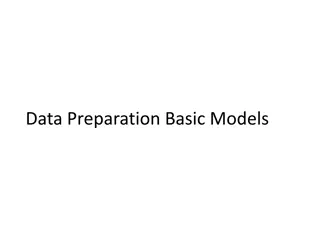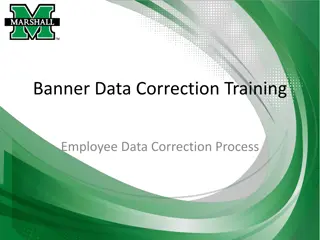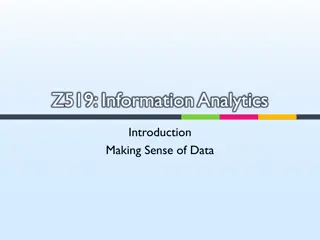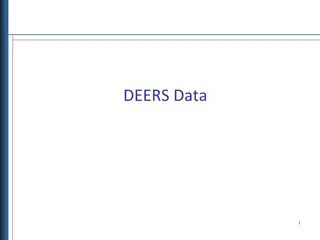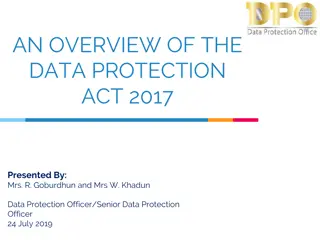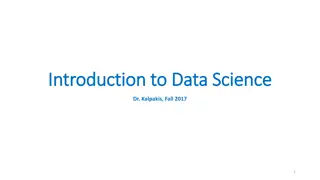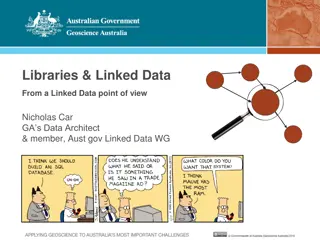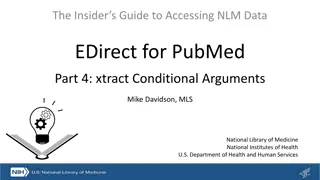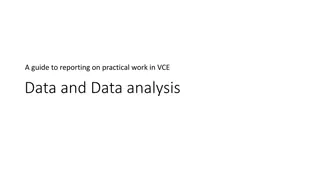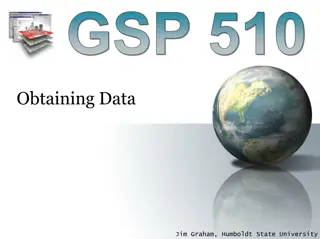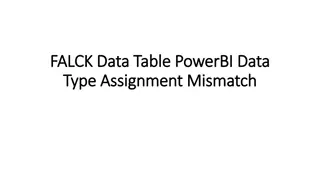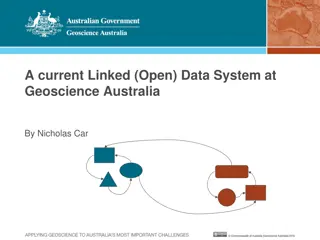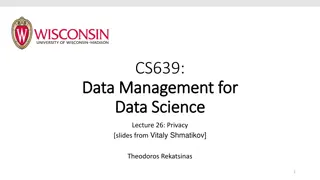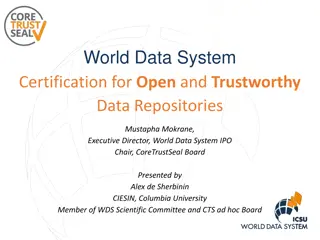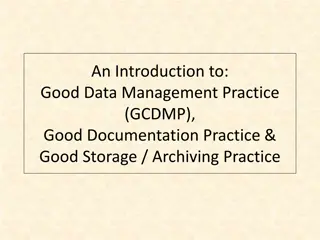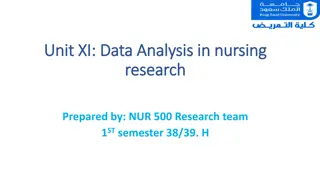Understanding I/B/E/S Data: A Comprehensive Guide
Comprehensive guide on I/B/E/S data, covering its history, importance, data categories, collection process, and unique identifier system. Learn about I/B/E/S Estimates and Guidance, data dimensions, data collection sources, and how analysts and brokers contribute to this valuable earnings estimate database.
Download Presentation

Please find below an Image/Link to download the presentation.
The content on the website is provided AS IS for your information and personal use only. It may not be sold, licensed, or shared on other websites without obtaining consent from the author. Download presentation by click this link. If you encounter any issues during the download, it is possible that the publisher has removed the file from their server.
E N D
Presentation Transcript
I/B/E/S @WRDS 101 Introduction and Research Guide Rui Dai Ph.D. CFA
Before I/B/E/S collected such data, consensus earnings estimates were difficult to obtain and highly ambiguous. W I L L I A M S H A R P E 2 Rui Dai, Ph.D. CFA
Institutional Brokers' Estimate System (I/B/E/S) I/B/E/S is recognized as the conventional analyst forecast data in academia Broker houses contribute to I/B/E/S with US data back to 1975 and International data back to 1987. Core Database used in Top Finance and Account Journals (2018) 0.059 400 350 0.057 300 0.055 250 0.053 200 0.051 150 0.049 100 0.047 50 0.045 0 CRSP Compustat Thomson SDC Bloomberg IBES Thomson Mutual Funds Factiva DataStream Thomson Reuters 13F Execucomp paper count eigenvalue 4 Rui Dai, Ph.D. CFA
Frequently used I/B/E/S data I/B/E/S Estimates It is an historical earnings estimate database containing analyst estimates. It includes more than 20 forecast measures - including EPS (earnings per share), revenue, price targets, EBITDA and pre-tax profits. The data available on both consensus and detailed levels, covering both U.S. and international companies. I/B/E/S Guidance It includes management's predictions about their own company It combines information previously available in the Company Issued Guidance (CIG) file in base I/B/E/S and information from the defunct First Call database 5 Rui Dai, Ph.D. CFA
I/B/E/S Estimates Data Categories Data Dimensions Detailed vs Consensus EPS vs No-EPS Adjusted vs Non-Adjusted US vs Non-US EPS EPS Non-EPS Non-EPS Detailed Consensus 6 Rui Dai, Ph.D. CFA
I/B/E/S Estimates Data Collection 3,000+ estimators(brokers) contribute data to I/B/E/S from the largest global houses to regional and local brokers, totaling over 30,000 individual analysts. Company actuals are collected from multiple newswire feeds, press releases, company websites and public filings. Detailed estimates are collected each day as they are released by analysts. Summary history consists of chronological snapshots of consensus level data taken on a monthly basis. 7 Rui Dai, Ph.D. CFA
Identifier System Permanent ID: I/B/E/S ticker, denoted as 'TICKER', is a unique identifier assigned to each security that is consistent throughout I/B/E/S History. Security ID: CUSIP/SEDOL data field contain historical CUSIP, or SEDOL when CUSIP is not available. Link I/B/E/S and Other databases See the programing guide on linking I/B/E/S with CRSP and Compustat 8 Rui Dai, Ph.D. CFA
I/B/E/S Jargon Parties: Estimator: Sell-side institution or contributor (mostly broker house) Analyst: analyst who makes the forecast and work for sell-side institution Indicators: Forecast Period Indicator (FPI): a code to identify estimates for forecasting period e.g. 6: Next Fiscal Quarter and 1: Next Fiscal Year Primary/Diluted Indicator (PDI): share base selected for a company Primary/Diluted Flag (PDF): share base selected for an estimate 9 Rui Dai, Ph.D. CFA
Forecasting Time Lines Dates: Announce date(ANNDATS): the date that the forecast/actual was reported Activation date(ACTDATS): the date that the forecast/actual was recorded by the data vendor Forecast Period End Date (FPEDATS): the date to which the estimate applies Review Date (REVDATS): most recent date that an estimate was confirmed as accurate Statistical Period (STATPERS): the date in a month summary statistics of estimates are calculated Reference: Kaplan, et al (2019): Truncating optimism 10 Rui Dai, Ph.D. CFA
Data Example Detailed adjusted EPS estimate table TICKER IBM IBM IBM IBM CUSIP 45920010 45920010 45920010 45920010 ACTDATS 18 Jan 06 18 Jan 06 18 Jan 06 18 Jan 06 ANNDATS 17 Jan 06 18 Jan 06 18 Jan 06 18 Jan 06 FPEDATS 31 Dec 06 31 Dec 06 31 Dec 06 31 Dec 06 ESTIMATOR 85 2191 16 ANALYS 49595 1032 10014 FPI 1 1 1 MEASURE EPS EPS EPS VALUE 5.8 5.9 5.8 ANNDATS_ACT 18 Jan 07 18 Jan 07 18 Jan 07 ACTUAL 6.06 6.06 6.06 On 17 Jan 06 (ANNDATS), analyst 49595 (ANALYS) at Estimator 85 (ESTIMATOR) predicts that the EPS for IBM with fiscal period ending 31 Dec 06 (FPEDATS) is $5.8 (VALUE) . This estimates was entered into the I/B/E/S database on 18 Jan 06 (ACTDATS).On 18 Jan 07(ANNDATS_ACT), IBM announced an actual EPS of $6.06 (ACTUAL) for this fiscal period. Consensus adjusted EPS estimate table TICKER IBM IBM IBM CUSIP 45920010 45920010 45920010 STATPERS MEASURE 19 Jan 06 16 Feb 06 16 Mar 06 FPI 1 1 1 NUMEST 23 23 22 MEDEST 5.8 5.8 5.8 MEANEST 5.79 5.81 5.8 STDEV 0.08 0.07 0.07 FPEDATS 31 Dec 06 31 Dec 06 31 Dec 06 ACTUAL 6.06 6.06 6.06 ANNDATS_ACT 18 Jan 07 18 Jan 07 18 Jan 07 EPS EPS EPS The Summary statistics calculated on 19 Jan 06 (STATPERS) shows that for forecast period ending 31 Dec 06 (FPEDATS), forecasted earnings per share has a median of $5.8, mean of $5.79 with standard deviation of 0.08, which is calculated from 23 esitmates. 11 Rui Dai, Ph.D. CFA
Accounting Background: Street Numbers Generally Accepted Accounting Principals define the earnings reported on financial statements, commonly referred to as "GAAP earnings However, in press releases and conference calls, managers and analysts often report earnings excluding items that appear in GAAP earnings (e.g., special items, stock-based compensation expense, etc.) The use and definition of these non-GAAP earnings numbers, popularly referred to as pro forma earnings" or Street earnings varies by firm So be aware that earnings on Compustat are GAAP, while I/B/E/S tracks Street Earnings Reference: Bradshaw and Sloan (JAR, 2002) GAAP vs. The Street: an Empirical Assessment of Two Alternative Definitions of Earnings 12 Rui Dai, Ph.D. CFA
Street Numbers v.s. GAAP Intuit reports the performance metrics in its 2006 earnings announcement: Difference +14% Q3 FY05 834.9 Q3 FY06 952.6 Revenue -1% +11% +11% GAAP net income Non GAAP net income 298.6 298.6 318.3 318.3 300.5 287.5 GAAP diluted EPS Non-GAAP diluted EPS 1.68 1.79 1.61 1.54 +4% +16% Street earnings (I/B/E/S) could exclude various expenses required by GAAP Note: there is another reason why Compustat reports different numbers from I/B/E/S: Compustat quarterly data reports restated values, while I/B/E/S includes the originally reported earnings. 13 Rui Dai, Ph.D. CFA
Rounding Issues in I/B/E/S Adjusted Summary Data I/B/E/S Adjusted Consensus files (easiest-to-use) are rounded to 2 decimals Key Factor: Shares Outstanding 1 to 4 Stock Split Earning Annq Earning Annq-1 Fiscal QTR Endq I/B/E/S sum dateq Estimated EPS= 1.01 (mean) Actual EPS= 0.99 Stock Price=2 Announced EPS= 0.25 Estimated EPS= 1.01 (mean) Estimated EPS= 0.25 (mean) I/B/E/S Adjusted Data Forecast Error: (0.25-0.25)/0.5=0. Forecast Error: (0.99-1.01)/2= - 0.01 15 Rui Dai, Ph.D. CFA
Rounding Issues Implication Payne and Thomas (2003) concludes rounding issues are pronounced among larger firms, higher M/B, better performers. Research implication: the proportion of zero forecast errors over time Market reaction Earning management The median of stock split is 1-to-2 among US common stocks, while the 95th (99th) percentile of same figure is 1-to-2.5 (1-to-4) Based on CRSP Factor to Adjust (shares), 12,626 stock-split events for 6,045 stocks from 1980 to 2019 Reference: Payne and Thomas (TAR 2003) " The Implications of Using Stock-Split Adjusted IBES Data in Empirical Research." Payne and Thomas (TAR 2003) " The Implications of Using Stock-Split Adjusted IBES Data in Empirical Research." Reference: 16 Rui Dai, Ph.D. CFA
Potential Solutions for Rounding Issue (Solution 1) Use I/B/E/S unadjusted consensus data and utilize cumulative factors to adjust data without rounding. Unfortunately, I/B/E/S effective split date is NOT necessarily the true date of the stock split. In fact, it is the date when the split became effective within the IBES database. (e.g. see Microsoft Quarterly Stats from Dec 89 to Jun 90.) The split date from other data source, such as CRSP, may be needed. CRSP TICKER AMZN AMZN AMZN AMZN AMZN AMZN AMZN AMZN AMZN AMZN AMZN ANNDATS 20 May 98 26 May 98 28 May 98 4 Jun 98 4 Jun 98 8 Jun 98 5 Jan 99 5 Jan 99 5 Jan 99 14 Jan 99 FPEDATS 31 Dec 98 31 Dec 98 31 Dec 98 31 Dec 98 31 Dec 98 31 Dec 98 31 Dec 98 31 Dec 98 31 Dec 98 31 Dec 98 ANNDATS_ACT 26 Jan 99 26 Jan 99 26 Jan 99 26 Jan 99 26 Jan 99 26 Jan 99 26 Jan 99 26 Jan 99 26 Jan 99 26 Jan 99 ANALYS 42186 1830 32051 42186 32051 45029 259 30593 32051 53564 VALUE 2.5 2.1 3.06 1.17 1.12 1.21 0.67 0.54 0.56 0.54 ACTUAL 0.517 0.517 0.517 0.517 0.517 0.517 0.517 0.517 0.517 0.517 CFACSHR ACTUAL Adjusted 6 6 6 3 3 3 1 1 1 1 3.102 3.102 3.102 1.551 1.551 1.551 TICKER STATPERS MEANEST FPEDATS ALK 15MAR2012 ANNDATS VALUE CFACSHR at Statistical Period CFACSHR at Earning Announcement 0.39 4 31MAR2012 19APR2012 2 0.71 Split 2-for-1 on 2-Jun-98 Unadjusted Consensus Estimates + Unadjusted Actual Announcement Split 3-for-1 on 5-Jan-99 0.517 0.517 0.517 0.517 ??????????= ??????? ??????? ?? ??????? ???????????? ??????? ?? ??????????? ?????? = 0.355 Unadjusted Detailed Estimates + Unadjusted Actual Announcement 17 Rui Dai, Ph.D. CFA
Potential Solutions for Rounding Issue (Solution 2) Recalculate I/B/E/S consensus statistics using the detail IBES adjusted data, which has rounding to 4 decimals. I/B/E/S consensus data includes only effective estimates while calculating the summary stats from detail, but provides no clear definition of what is considered an effective estimate. No way has been found to perfectly reconstruct I/B/E/S Summary data even in early years. I/B/E/S may be lumping forecasts of different analysts from a same estimator. Shevorob (2006) suggests the latest estimate for a given estimator is included (Appendix I) It is found that estimators and analysts have been removed from the estimate database, which may cause further data inconsistence in between detailed and consensus metrics. Reference: Shvorob (WRDS 2006) A Note on Recreating Summary Statistics from Detail History 18 Rui Dai, Ph.D. CFA
Rewriting History Ljungqvist, Malloy and Marston (JF, 2009) document widespread changes to the historical I/B/E/S analyst stock recommendations: Across seven I/B/E/S downloads, obtained between 2000 and 2007, authors find between 1.6% and 21.7% of matched observations are different from one download to the next Four types of changes: alterations, deletions, additions and anonymizations Non-trivial implications on research that analyzes Profitability of trading signals and consensus recommendation changes Persistence in individual analyst performance (analysts track records). Reference: Ljungqvist, Malloy, and Marston (JF 2009) Rewriting History . Alpert (WSJ 2007) Mysterious Changes in Key Wall Street Data . 19 Rui Dai, Ph.D. CFA
Vanishing History The finding of Ljungqvist et al. (2009) does not extend to the I/B/E/S earnings forecast data (see Wu and Zang 2009). Call et al (2020) finds substantial differences in the contents of these two versions of the detailed file from 2009 and 2015. 11.68% of detailed estimates in 2009 vintage is no long in 2015 vintage, and 6.01% vice versa. Call et al (2020) also finds changes made to the summary file are much less common than changes made to the detail file. Only 0.11% of summary estimates in 2009 vintage is no long in 2015 vintage, and 1.49% vice versa. Reference: Call et all (2020) Analysts Annual Earnings Forecasts and Changes to the I/B/E/S Database . Wu and Zang (2009) What determine financial analysts career outcomes during mergers? . 20 Rui Dai, Ph.D. CFA
Institutional Background Through interviews with I/B/E/S high-end representatives, the authors learn that many brokerages have the contractual right to restrict access to their analyst forecast. Upon requests, I/B/E/S would cease or activate distribution of their forecasts, even retroactively. This could be confirmed by many correspondences between WRDS and I/B/E/S: [T]he great majority of the records missing in the July 2007 vintage are for brokers Merrill Lynch (non-US and Canada) and Lehman Brothers (Europe and Global), due to requests from the two brokers that WRDS does not have access to their forecast data The finding of Call et all. (2020) also is consistent to the conjecture that many brokerages, like Goldman Sachs, only supply estimates to the summary files but not the detail files 21 Rui Dai, Ph.D. CFA
Encrypted History (Bad News for Academia) To better adapt regulatory compliance (such as MiFID II), I/B/E/S changed the identifiers of a large number of brokers and analysts as of October, 2018. The estimator and analyst names from 88 contributors will be anonymized in detailed estimates data The estimates from UBS will be removed from the I/B/E/S detailed estimates data Through a conference call, I/B/E/S further inform WRDS individual broker IDs (and all affected analysts) have been and will continue to be subject to reshuffle without warning. The analyst id reshuffle may further complicate the inconsistent analyst code issue documented in Roger(2016). Reference: Roger (2016) Reporting errors in the I/B/E/S earnings forecast database: J. Doe vs. J. Doe . 22 Rui Dai, Ph.D. CFA
Encrypted History (Cont.) Pierson (WRDS 2020) compares two I/B/E/S detailed files from 2014 and 2019 vintage to calibrate the impact made in Oct 2018. The data from two vintage are matched based on estimated amount, announcement data, security, etc. except analyst and estimator codes. It is likely that 13.8% of all broker IDs (ESTIMATOR) has been modified, consistent to the listed 89 brokers Also I/B/E/S may have resigned up to 30.7% of all analyst IDs (ANALYS), many of whom are not necessarily associated with those 89 brokers Fortunately, the changes are only made to detailed estimate datasets, presumably due to regulatory concerns. There will be no change to the I/B/E/S Summary History estimates product (consensus). Detailed estimates from all Pre-Approval brokers, including UBS, will remain within all summary/consensus calculations in accordance with existing methodology. Reference: Thomson Reuters Product Change Notification ref: CN 082718 23 Rui Dai, Ph.D. CFA
Takeaways Working with I/B/E/S requires good understanding of some issues: Be aware of rounding issues in Adjusted Consensus which may lead to biased estimates of earnings surprises More recent version of the detail file does not reflect more comprehensive historical analyst estimates Consensus estimates in the summary file may be the best proxy for the market s expectations Further Material WRDS Research Application: Post-Earning Announcement Drift (PEAD) Replication Tutorial: SUE and PEAD with Compustat and I/B/E/S data 24 Name of Initiative
Appendix I: Recreating Summary Statistics from Detailed File Consensus File: TICKER BIT MEASURE EPS FPEDATS 12/31/2004 FPI 1 STATPERS 10/14/2004 NUMEST MEANEST 2 STDEV 0.01 ESTFLAG P 0.14 Detail Table: TICKER BIT BIT BIT BIT BIT BIT MEASURE EPS EPS EPS EPS EPS EPS FPEDATS 12/31/2004 12/31/2004 12/31/2004 12/31/2004 12/31/2004 12/31/2004 FPI 1 1 1 2 2 2 ESTDATS 2/9/2004 5/7/2004 8/3/2004 7/8/2003 10/9/2003 2/9/2004 ESTIMATOR 2192 2192 1996 1876 1876 1876 ANALYS 9479 72066 107152 7646 7646 7646 VALUE 0.14 0.15 0.14 0.23 0.19 0.22 Drop Reason Superseded Stopped (In Stop Table ) Stopped (In Stop Table ) Excluded(In Exclusion Table) Exclude Table: Estimates removed from the consensus but still observable to clients TICKER BIT MEASURE EPS FPEDATS 12/31/2004 FPI 2 ESTDATS 12/10/2003 BROKER 1876 ANALYS 7646 VALUE 0.22 EXCDATS 4/16/2004 Stop Table: Estimates removed and no longer observable TICKER BIT MEASURE EPS FPEDATS 12/31/2004 PDICITY A BROKER ESTPDATS 1876 4/20/2004 Reference: Kaplan Martin and Xie (2019) Truncating optimism. 26 Name of Initiative
Rounding Issues in I/B/E/S Adjusted Data Historically, I/B/E/S provides estimate data on an adjusted basis, rounded to 2 decimal on the Consensus files and to 4 decimals on the Detailed files. How would this be an issue? Adjusted EPS after a 4- for-1 Stock Split 0.25 0.25 0.00 Unadjusted EPS Company A Earnings Forecast Forecast error 0.99 1.00 -0.01 Company B Earnings Forecast Forecast error 1.01 1.00 0.01 0.25 0.25 0.00 Reference: Payne and Thomas (TAR 2003) " The Implications of Using Stock-Split Adjusted IBES Data in Empirical Research." 27 Rui Dai, Ph.D. CFA




